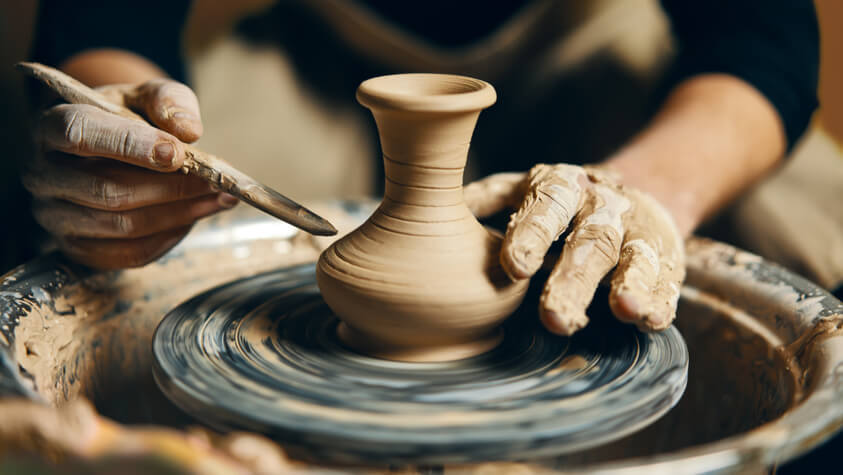By TACP Staff on July 08, 2021

Ceramic artists take elements like clay, carbide, non-metallic materials, nitride, carbon, silicon, inorganic materials, and crystalline oxide to create any number of artistic or functional items. Since the industrial revolution heralded the mass production of many items previously made by hand; ceramicists are widely considered talented artisans, and are well-respected as well as financed by artistic communities.
Ceramics are objects made from earthenware materials, such as clay. Some examples of ceramic items may include dishes, vases, tiles, and figurines. There are several different methods for shaping clay to make ceramic items. Dishes, like bowls and vases, are typically shaped by placing them on the center of a pottery wheel. This device has a thick heavy round plate that spins. As the lump of clay spins, a ceramicist shapes it with his hands.
To make figurines, a mixture of clay and water, known as a slip, is poured into a plaster mold. When the outside edges of the slip start to dry, the liquid in the center is poured out. The figurine is removed from the mold when it is nearly dry.
After ceramic items are allowed to dry, they must also be placed in a special oven known as a kiln. The high temperatures inside the kiln help evaporate any moisture left in the clay, causing the piece to harden. Many times, a glaze is brushed onto the piece as well, which contains ingredients that melt in the intense heat of the kiln and form a glassy coating on the surface of the piece.
A ceramic artist makes clay and porcelain objects. Some ceramicists specialize in making certain types of items, like dishes, while others may choose to create several different types of items. In order to create their art, ceramicists must first obtain clay. While some ceramicists choose to buy clay from pottery supply stores, others may choose to actually dig their own. In order to do this, a ceramicist must know how to find and prepare natural clay.
The method that ceramicists use to create pieces will vary, depending on what he specializes in making. A ceramicist that makes dishes and vases will usually use a pottery wheel, for example, while a ceramicist who makes figurines will usually use several different plaster molds. Some ceramicists create their pieces freehand, using not equipment and tools other than their own two hands.
When his pieces are dry, a ceramicist will then usually carefully place them in a kiln. The pieces can either be painted with a glaze before being placed in a kiln, or they can be painted with regular paint after being removed.
Although some ceramicists are able to learn their skills on their own, formal education in ceramics or a related field can be helpful when starting a ceramics career. Many aspiring ceramicists discover their interest in this art form during high school art classes. Some individuals might also choose to take private ceramics classes as well.
Some aspiring ceramicists might also benefit from earning a two or four-year degree from an art school. Degrees in fine arts and sculpting can both help an aspiring ceramicist hone his skills. Certain art schools also offer pottery or ceramics programs as well.
The average salary of a ceramicist can be difficult to pinpoint, and since many ceramicists work as freelancers, the Bureau of Labor Statistics does not collect data about these professionals specifically. The Bureau of Labor Statistics, however, does state that fine artists – including sculptors – made an average annual salary of about $53,080 in 2010. In that same year, craft artists made an average annual salary of $32,010.
The majority of professional ceramicists work as freelancers. They work in studios and design and create different ceramic pieces to sell them. Some ceramicists open their own stores, while others may sell their pieces at craft co-ops or on the Internet. Teaching is another possible career path for ceramicists. High schools and colleges sometimes hire ceramic professionals to teach classes, and some ceramicists may be able to give private lessons.
Consider these related careers in Craft and Fine Art.

The Art Career Project is a trusted resource for emerging and professional artists.